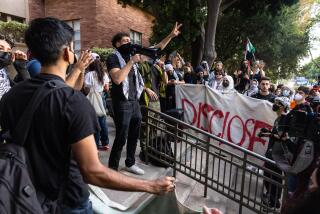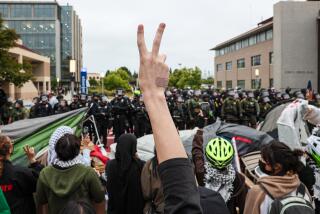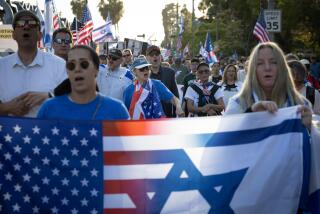ISLAM RISING : United States : Muslims Enter American Mainstream : The second generation is at home with U.S. social and political norms and proud of its heritage. But it’s worried about prejudice and misunderstanding.
First came the thunderous explosion that rocked the World Trade Center in New York.
Within days, the arrests of Arab immigrants and a naturalized U.S. citizen of Palestinian descent made news around the world.
“Muslim Arrested!” screamed a headline in an Eastern newspaper.
Muslims in the United States had seen it before. The words and images ran together like watercolors on a child’s easel-- Arabs, mosque, terrorism, Muslims, extremists --making it hard to tell where one began and another left off. The result, they said, was a blur of fear and misunderstanding of them and their faith.
For millions of Muslim Americans, the picture not only has distorted the obvious (all Muslims are neither terrorists nor Arabs) but also has failed to convey a central fact of Muslim life in the United States today:
A torch is being passed to a new generation that is middle-class and politically savvy, with concerns that are as representative of America as an Aaron Copland suite.
To be sure, the members of this generation are concerned with the plight of Muslims in Bosnia. They dream as fervently of a Palestinian homeland as did Jews of the establishment of Israel before 1949. They agonize over the murderous religious clashes between Hindus and Muslims in India.
But Muslim Americans also worry about crime in the streets, the quality of education and jobs. They talk about taxes and the economy.
“Muslims in America are 6 million people,” said Maher Hathout, chairman of the Islamic Center of Southern California. “The majority of them are breadwinners. They are hard-working, taxpaying, law-abiding people.”
The first generation of Muslims, like other immigrants, concentrated on building a life in America--sometimes in the face of negative stereotypes about Muslims. Now, those in the second generation--at home with American social and political norms and proud of their heritage--are entering the political and cultural life of the nation.
“The (Muslim) community is maturing, and the second generation is here,” said Zahid Bukhari, secretary general of the Islamic Circle of North America, based in Jamaica, N.Y. “Now they feel they are mature enough financially and to some extent (in) human resources that we should be a part of the American mainstream and become politically active.”
In times of crisis, such as the New York terrorist bombing, second-generation Muslims still turn to one another for support. “People are feeling like we need more to huddle together, to speak (with) the voice of sanity,” Hathout said, “because the religion itself is projected negatively and because of a certain danger to Muslims here.”
Nonetheless, few doubt that the Muslim community is in transition. It is reflected in the lives of young people and in the growing vitality of the community’s political voice.
“When I was growing up, my parents stressed that I not make waves, not rock the boat--so I didn’t,” said 24-year-old Qamarul Huda, a UCLA history student. Huda recalled being told not to draw attention to himself as an Iranian Muslim during the Iranian hostage crisis 13 years ago. “The generation of Muslims raised here . . . is becoming more creative, getting involved in the arts, becoming activists. I have a friend who was on the med school track who is now a lobbyist. I know someone else who wants to run for state senator. . . .”
While their activities pale in comparison with the well-heeled efforts mounted by other interest groups, Muslim Americans are running for office, lobbying Congress and courting local politicians.
In Southern California, two Muslim Americans ran last June for their parties’ congressional nominations. Although both lost in the primaries, their entry was viewed by fellow Muslims as a watershed. The Muslim Public Affairs Council in Los Angeles is meeting with the top contenders in the Los Angeles mayor’s race and with Clinton Administration officials on foreign policy matters.
The fledgling United Muslims of America in Sunnyvale, Calif., with 500 members nationwide, co-sponsored hospitality suites at California state Democratic and Republican party conventions. In Washington, D.C., the new American Muslim Council is encouraging Muslims to register to vote.
In Orange County, Islamic scholars and theologians have joined in a rare collaboration with Christian and Jewish colleagues to explore where the three Abrahamic faiths converge. The effort by the Academy for Judaic, Christian and Islamic Studies in Anaheim is the first of its kind in the nation.
As fighting continued between Bosnian Muslims and Serbs, four Muslim organizations that claim to represent the majority of Muslims in the United States formed the Bosnia Task Force U.S.A. to lobby Congress to lift the arms embargo and to push for enforcement of a “no-fly” zone over Bosnian territory. (The U.N. Security Council authorized shooting down of aircraft violating the zone last Wednesday.)
Muslims in America are in a unique position to be a “window into Islam” for American policy-makers, according to Hathout. “American opinion leaders need to understand the feelings and thinking of Muslims at large,” he said.
An emerging cadre of young leaders in Southern California maintains that humanitarian efforts to send relief supplies to Muslims overseas must go hand in hand with political pressure on the American government.
The Muslim Women’s League, for example, dispatched a delegation of Jewish, Christian and Muslim women to meet with rape victims in Bosnia while also meeting on the political front with U.N. officials and mailing hundreds of postcards to members of Congress.
A unified front is a departure from Muslims’ usual approach. Historically, they have paid most attention to events in their homelands. But the Bosnian crisis, like the Palestinian issue before it, has prompted Muslims of diverse ethnic and national backgrounds to speak as one.
That is no easy task considering the fact that the U.S. Muslim community is far from monolithic. Aside from their belief that there is one God and his name is Allah and that the Prophet Mohammed was his messenger, theological differences among Muslims--not to speak of cultural differences--rival those in Christianity. There are at least 73 sects in Islam.
The first Muslims in America were Africans brought as slaves in the 17th Century, and members of the faith have come in successive waves since then. As recently as the 1950s, African-Americans made up 65% to 70% of all Muslims in the United States, according to Muzaffar Ahmad Zafar of Dayton, Ohio, national first vice president of the Ahmadiyya Movement in Islam Inc.
Thousands of African-Americans were drawn to Islam in the 1950s and ‘60s by the teachings of Elijah Muhammad and his organization, the Nation of Islam. However, only a small minority of black Muslims today are members of the Nation, now headed by Louis Farrakhan.
Most black Muslims have since affiliated with other groups within Islam, including a group led by W. D. Muhammad, the son of the late Elijah Muhammad, who took over after his father’s death in 1975 and brought the black nationalist sect into the mainstream of Islam, according to Ihsan Bagby, director of the Islamic Resource Institute.
Today, African-Americans account for 42% of the Muslims in the United States, while immigrants represent the majority of Muslims here. Nonetheless, Islam continues to attract new converts from among black Americans, largely, adherents say, because of its egalitarian ethos.
Arabs and Middle Easterners make up about 20% of the population, while South Asians--mostly from India, Bangladesh and Pakistan--are nearly a fourth of the total, according to the American Muslim Council. Others are from Malaysia, Indonesia and North Africa.
Of the estimated 5 million to 6 million Muslims in the United States, 1 million to 1.5 million are in California. There are more than 1,500 mosques in the United States and more than 100 in California.
“Our cultural diversity can be seen as an initial handicap,” said Salam Al-Marayati, executive director of the Muslim Public Affairs Council in Los Angeles. “But it is an element of empowerment to mobilize Indian Muslims for Bosnia, African Muslim Americans for Palestine.”
On college campuses, Muslim students are stepping forward by organizing an estimated 200 chapters of the Muslim Students Assn. of North America.
On the East Coast, Muslim Americans joined a noisy but orderly demonstration outside the Jersey City, N.J., mosque of the fiery Islamic cleric Sheik Omar Abdul Rahman to protest media coverage that they said stereotyped all Muslims as terrorists. Several of those arrested in the World Trade Center bombing worshiped at the mosque, authorities said.
There are other indications that the Muslim-American community is coming out of obscurity. For 10 years, a mosque in Northridge did not even have a sign in front for fear of being targeted by anti-Muslim violence. This year, tired of being in hiding, the Islamic Center of Northridge installed a sign and purchased bus bench ads in the San Fernando Valley to publicize itself.
The entry into the American mainstream is not without a price. Like immigrants from other lands, Muslims sometimes find it difficult to preserve their Islamic religious and cultural heritage while fitting into the American mainstream.
Some Muslim women are forgoing the veil. A Muslim engineer in the Valley said that his beard--perceived as a distinct Muslim feature--became a liability in the aftermath of the World Trade Center bombing. Nor is it easy to bow down in prayer five times daily.
In rural areas far from the the cosmopolitan life of big cities, Muslims sometimes Anglicize their names to avoid discrimination. “A number of people, particularly in Detroit-Akron-Toledo areas, come from Muslim families and have been Muslims all along, but they’re using names like Mike, Joe and Sam. . . . There are many underground Muslims,” said Muzaffar Ahmad Zafar, of the Ahmadiyya Movement in Islam.
Perhaps most galling, especially for first-generation Muslims, is the fact that living in a highly secular society, in ways both overt and subtle, can draw Muslims away from what they see as the will of Allah.
Many Muslims, pointing to crime, high divorce rates and a seeming obsession with sex in entertainment and advertising, see American and Western society in general as morally lax and worry about their children.
Yet, in the face of cultural, political and social obstacles, their hope lies in their children.
“Some of us are a bit too shy in terms of politics, or we feel not fully competent to speak on political issues,” said Waheed Siddiqee, a first-generation Muslim from Pakistan and the father of two sons. “But . . . we have great hope and expectations from these young people who have grown up here (and) know the system.”
More to Read
Sign up for Essential California
The most important California stories and recommendations in your inbox every morning.
You may occasionally receive promotional content from the Los Angeles Times.









